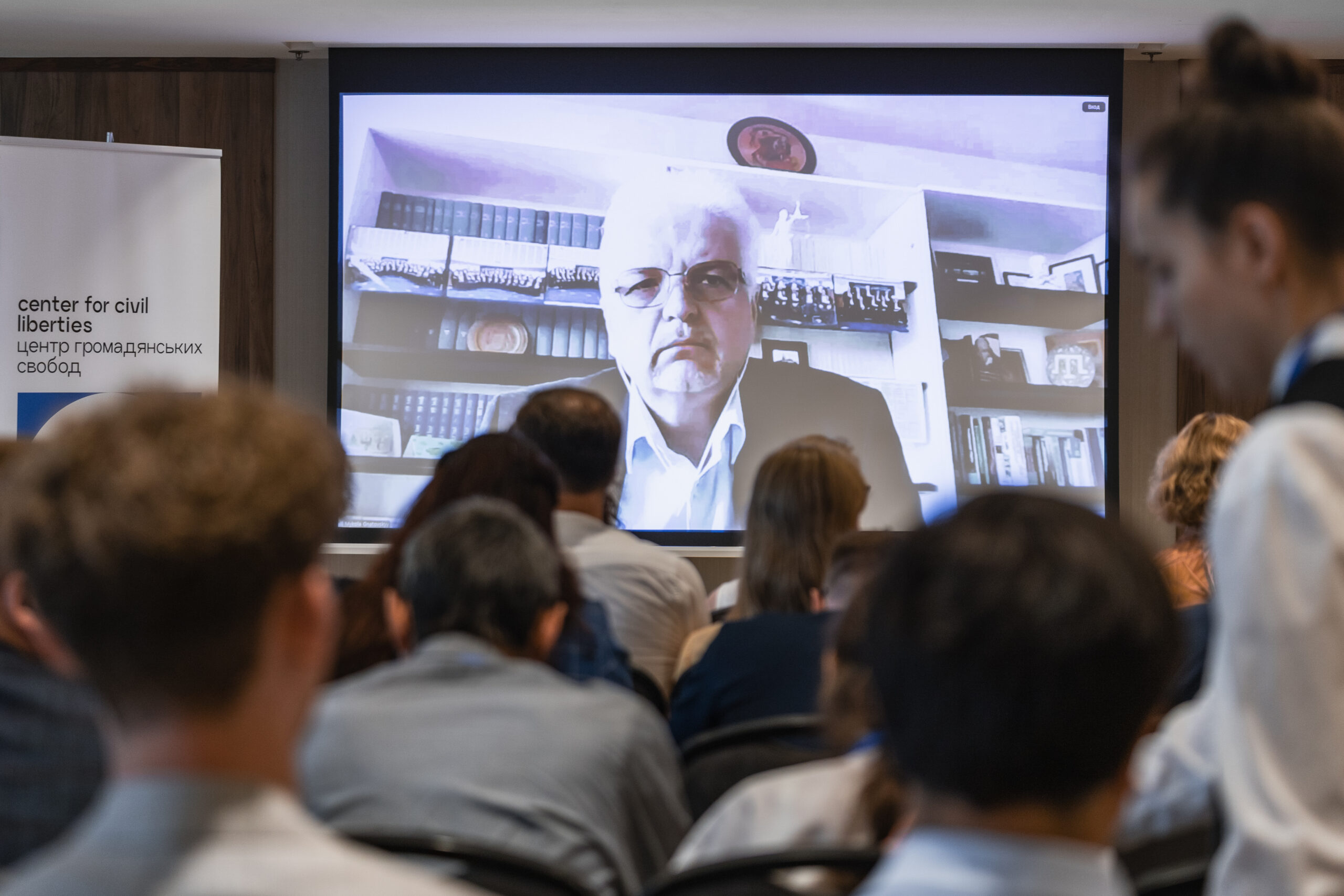On July 14, within the framework of the Ukrainian International Criminal Justice Week, held for the sixth time by the Center for Civil Liberties, a webinar “Environmental Crimes under Ukrainian and International Law” was held by Michael Kelly, Professor of Law at Creighton University (USA) and Director of the Cayman Center for International Criminal Justice, which helps Ukrainian prosecutors prosecute environmental crimes. The expert outlined the state of Ukrainian and international legislation on environmental crimes, the role of Ukraine’s experience in its development, and the prospects for its application in court practice. Here are the notes from the event.
Environmental crimes in the context of the Russian Federation’s war against Ukraine
The armed aggression of the Russian Federation against Ukraine has had a devastating impact on the environment. Environmental crimes are committed during hostilities by all branches of the military. For example, the Russian Navy has killed between 37500 and 48000 dolphins, i.e., every sixth dolphin in the Black Sea, through shelling, mines, and intensive use of sonar. Notably, even land-based operations harm dolphins – the destruction of the Kakhovka hydroelectric power plant resulted in thousands of liters of contaminated water in the Black Sea, which can also be considered a separate environmental crime. According to experts, the continuation of the war could lead to the complete extinction of dolphins in Ukraine.
In addition, the Russian military has resorted to bombing forests, polluting waterways, and mining protected areas and agricultural land. Currently, about a third of Ukrainian fields are contaminated with unexploded ordnance, which significantly damages agriculture and threatens food security.
These crimes shock the international human rights community and prompt the development of an effective international mechanism to bring perpetrators to justice. Ukraine’s experience can change the understanding of environmental crimes and determine the further development of international law in this area.
The place of environmental crimes in international and Ukrainian legislation
Investigations of environmental crimes at the ICC level can take place in the context of crimes against humanity, war crimes, or crimes of aggression. There are no separate provisions on ecocide in the Rome Statute, but the Assembly of Member States in 2024 attempted to include ecocide in the ICC’s jurisdiction. The changes were not implemented, but were widely supported. Experts believe that criminalizing ecocide can prevent its recurrence in the future, complement the provisions of Article 8.2(b) of the Rome Statute on war crimes, and help protect the environment. On the other hand, criminalizing environmental crimes requires their precise definition, clear mechanisms for establishing intent, and links between the act and its consequences.
Under a new international treaty being developed by the UN Commission on International Law, environmental damage could also be included in the list of crimes against humanity. The Rome Statute and the work of international criminal tribunals do not contain separate provisions on environmental crimes. The perpetrators can only be brought to justice if the objective component of the crime (actus reus) and the guilt can be identified.
Michael Kelly argues that the Ukrainian experience can broaden the understanding of ecocide and calls for it to be defined as “widespread, long-term or serious damage to the environment, including biodiversity, natural resources, agriculture or landscapes, with the intent to harm civilians.” In his opinion, the inclusion of agriculture in the environmental components will make it easier to bring the Russian military to justice for contaminating Ukrainian fields with ammunition. An equally important part of this definition is the intent to harm civilians, which is an essential component of crimes against humanity. If it cannot be proved, opening proceedings for an environmental crime in this legal framework will not be possible. Therefore, Ukrainian law enforcement agencies and the international human rights community should join forces to create a separate legal mechanism for investigating environmental crimes.
Ukrainian legislation allows for two ways to qualify Russian environmental crimes: as war crimes or as cases of ecocide. Each of these ways has advantages and disadvantages in collecting evidence and a trial. The choice of Ukrainian law enforcement may determine how environmental crimes are investigated internationally in the future. “You will do something that the rest of the world has not done yet. In public international law, cases do not set a precedent, but practice does so that Ukraine can lead in this,” said Professor Kelly.
Crimes against the environment are a type of war crime
Environmental crimes as a type of war crime can be prosecuted under Article 438 of the Criminal Code of Ukraine, which deals with violations of the laws and customs of war and is in line with the Geneva Conventions. It can be used in conjunction with Article 8.2(b)(IV) of the Rome Statute, which covers “intentionally attacking with the knowledge that it will cause death or injury to the civilian population or destruction of civilian objects or widespread, prolonged and severe damage to the environment, manifestly disproportionate to a specific and clear military advantage expected”. Article 55 of the First Additional Protocol to the Geneva Conventions also obliges combatants to make efforts to protect the natural environment. It prohibits methods of warfare that may damage it and endanger the health and life of the population.
Despite the broad regulatory framework, difficulties may arise during the trial of war crimes against the environment. For example, the defendant may argue that he or she caused environmental damage out of military necessity. The ICC considers the destruction of the natural environment to be justified if it was carried out to achieve a clear military objective, such as to weaken the enemy’s military capabilities. Officers on the battlefield and at headquarters assess the appropriateness of such damage. Therefore, it is possible to refute the argument of military necessity by proving that the officer intended or foresaw environmental damage in protected areas. For this purpose, a map of protected areas regularly updated by the Ministry of Natural Resources and Environment of Ukraine will be useful. As of 2024, it documented the damage caused by Russia’s armed aggression to 30% of Ukraine’s protected areas. An illustrative example is the theft of rare animals and plants from the Askania Nova Nature Reserve in the Kherson region. It can be expected that the Russian command has these maps and deliberately orders disproportionate damage to the natural environment. The main task of the prosecution in this case is to prove a direct causal link between the commander’s order and the environmental damage.
Another problem may be measuring the damage caused to the environment, which, according to international law, must be “widespread and long-term or serious.” According to Michael Kelly, involving the scientific and expert community in quantifying the consequences of environmental crimes is necessary.
On the other hand, under the Rome Statute, the prosecution may refer to the need to protect the environment as a civilian object in court. Even under occupation, the natural environment remains the property of Ukraine, which legally obliges the Russian military to avoid environmental damage. Therefore, ecological crimes and crop theft committed by the enemy in the temporarily occupied territories should also be documented and considered in court.
Crimes against the environment as ecocide
Article 441 of the Criminal Code of Ukraine allows the conviction of perpetrators of environmental crimes for ecocide. It provides for imprisonment for a term of 8 to 15 years for “mass destruction of flora or fauna, poisoning of the atmosphere or water resources, as well as other actions that may cause an environmental disaster.” Criminal proceedings under this article can be initiated even before a natural disaster actually occurs.
For the practical application of this provision of the Criminal Code and the proof of crimes in court, it is necessary to clarify what degree of damage constitutes “mass destruction” of flora and fauna and what “poisoning of the atmosphere and water resources” means. The development of clear quantitative criteria for measuring the damage will speed up court proceedings and ensure that all defendants are equal before the law.
A necessary step to create an adequate legislative framework for environmental crimes that would meet the realities of war is to introduce a unified understanding of ecocide as “an unlawful and intentional act committed with the knowledge that there is a high probability of serious and widespread or long-term damage to the environment.” Unlike the one proposed by Article 8.2(b)(IV) of the Rome Statute on war crimes, this formulation sets fewer requirements for the elements of crimes against the environment. It expands the freedom of law enforcement agencies to open and consider such proceedings.
Difficult aspects of environmental crime trials
Regardless of how an environmental crime is classified, several problems may arise during the investigation.
- First, proving direct intent remains a difficult issue, but it is necessary to bring perpetrators to justice under international and Ukrainian law.
- Secondly, natural objects or environments damaged by the Russian army may not be included in the list defined by the current legislation. In this case, relevant international legal norms and customs will need to be resorted to.
- In addition, most Russian officers who are guilty of environmental crimes will only be convicted in absentia. Even if absentia sentences are not enforced, they will create a practice of judicial review of similar crimes at the national and international levels.
Finally, for the proper administration of justice in cases of environmental crimes, they must be thoroughly documented. Essential aspects of this process include recording crimes against the environment in the temporarily occupied territories with the involvement of civil society organizations, using the testimony of Russian prisoners of war about the criminal orders of their commanders, and expert quantification of the damage caused to the environment.
International law on environmental crimes currently offers guidelines rather than clear instructions for their investigation. The Criminal Code of Ukraine allows for the qualification of ecological crimes committed by the Russian military in Ukraine as a type of war crime or ecocide. Using national legislation in parallel with international law will help fill possible gaps and ensure real punishment for criminals.
Regardless of the chosen method of qualification, law enforcement officers may face several challenges in collecting evidence, determining the composition of environmental crimes, and measuring the damage caused. Ukraine’s cooperation with international partners will help develop a clear definition of environmental crimes and an effective mechanism for their investigation. The experience of the Russian-Ukrainian war can broaden the understanding of ecological crimes and give impetus to innovations in criminal prosecution and further counteraction to ecocide.
The author of the summary: Oleksandra Helemendyk, a volunteer at the Center for Civil Liberties.







